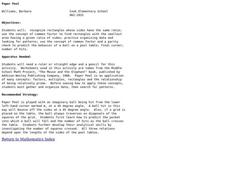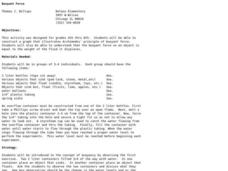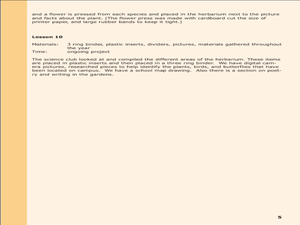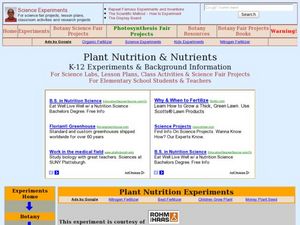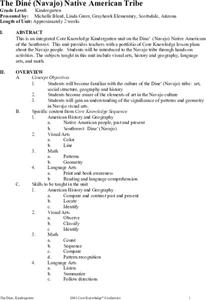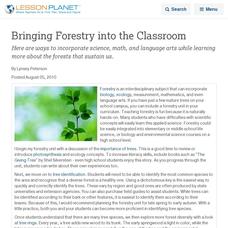Curated OER
Counting By 5s
Second graders count by 5's to 100. In this math instructional activity conducted on the 100th day of school, 2nd graders use picture stamps in the KidPix program to count by 5's and get to 100.
Curated OER
Forces Applied to an Object
Fourth graders predict, observe, and compare what happens when a force is applied to an object. In this forces lesson plan, 4th graders complete a 'swinging hammer' activity to learn about forces and motion.
Curated OER
The Segregated Pencil Sharpeners
Students explore racism through pencil sharpeners. In this civil rights lesson, students utilize a pencil sharpener with one of two colored pencils and explain how some people were not allowed to use certain items because of the color...
Curated OER
How Does Your Garden Grow?
Students create a design for a school garden. In this garden design lesson plan, students analyze what plants grow best in their school's climate and work in teams to design a garden. Students measure the existing space, determine the...
Curated OER
Fall Clothing Sale
Students shop for clothing. In this fall clothing sale lesson, students examine circulars for items to purchase within their budget.
Curated OER
Paper Pool
Students analyze the measurements of rectangles. In this analysis activity, students will investigate patterns by looking at ratios. Students will also hypothesize the probability of a ball going into a certain pocket when playing pool....
Curated OER
How Can You Detect the Invisible?
Students participate in a lab activity in which they examine the characteristics of radon. They identify radon's link to cases of lung cancer. They complete a radon fact sheet and answer questions to end the lesson plan.
Curated OER
Sunlight Necklaces
Third graders review the placement and role of the sun in the solar system. Using beads, they create a necklace which they can use to identify the amount of sunlight is being illuminated. In groups, they record observations on the...
Curated OER
Fraction Message
Students practice identifying fractional parts represented in pictures and phrases. In this fraction lesson, students determine the proportion represented by common time and money phrases such as "3 hours in a day". Students match their...
Curated OER
Buoyant Force
Students illustrate Archimedes' Principle of Buoyant Force. For this graphing lesson, students will observe that the buoyant force on an object is equal to the weight of the fluid it displaces. Students will then create a graph showing...
Curated OER
Ratios and Proportions
Seventh graders explore the concept of ratios and proportions. In this ratios and proportions lesson, 7th graders work in groups to measure their heights and their arm span. Students compare their height to their arm span. Students make...
Curated OER
The Sine Function
Young scholars explore the concept of the sine function. In this sine function activity, students use a plexiglass sine wave generator to visualize the sine function. Young scholars use a computer program/calculator to adjust aspects of...
Curated OER
Recycling & Our Environment
Students present information about recycling to other students. In this environmental protection lesson, students create a puppet show or commercial about the importance of recycling for other students to view.
Curated OER
Nature Oriented Kindness Projects
Students complete various nature activities where they work together to create a butterfly garden, plant flowers, learn about nature survival, and more. In this nature lesson plan, students work together in groups and display kindness...
Curated OER
Plant Nutrition and Nutrients
Students observe seeds growth and examine the different parts of the seedling. In this biology lesson, students compare the growth of seeds planted in soil and in hydroponics. They record their observations in their science journal and...
Curated OER
Mathematics Alive: Environment and Design of Human Habitats
Third graders explore the structural composition of buildings and houses. In this math lesson, 3rd graders explain how architecture is related to mathematics. They create a blueprint of a structure with at least three different spaces.
Curated OER
The Díne (Navajo) Native American Tribe
Students participate in a variety of activities to become familiar with the Navajo Indians. In this Díne (Navajo) Native American tribe lesson, students understand where the Navajo tribe lived and find them on a map. Students discuss the...
Curated OER
Animal Science Research Report
Students research an animal. In this research lesson, students utilize various types of technology to gather information about an animal. Students create a class blog and use digital photography for their research.
Curated OER
Density
Students determine the density of different substances. In this physical science lesson, students rank them according to their density. They discover the relationship between volume and density.
Curated OER
Life Skill Communication
Students use digital camera to document the needs for daily living. In this life skills and visual arts lesson, students create class books that include photographs of everyday objects that they use in their home, school and personal...
Curated OER
Why is it so hot when I sit next to the window?
Students investigate how energy travels through glass. For this energy usage lesson, students conduct an experiment in which they decide if window film affects how much energy travels through the glass. Students use a journal to make...
Curated OER
Rounding Decimals
Fourth graders explore rounding a price given in dollar and cents to the nearest dollar. In this math lesson, 4th graders discover how to round to the nearest dollar. Additionally, students practice rounding money for objects that they...
Curated OER
Bringing Forestry into the Classroom
Here are ways to incorporate science, math, and language arts while learning more about the forests that sustain us.
Curated OER
How Plants Help Us Breathe
Third graders discuss how humans breathe and how plants help us to stay alive. In groups, they identify and label the different parts of plants and describe their functions. They compare and contrast the ways plants and animals breathe...







